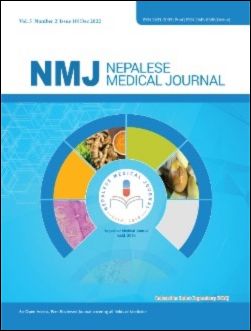Prevalence and Pattern of Birth Defects in a Tertiary Hospital in Lalitpur, Nepal
DOI:
https://doi.org/10.3126/nmj.v5i2.51762Keywords:
Birth defects; Congenital anomalies; NewbornsAbstract
Introduction: Birth defect is one of the least studied areas in most developing countries like Nepal where low birth weight, prematurity, sepsis, and perinatal asphyxia are still the leading causes of neonatal and infant mortality. However, studies have shown that the incidence of birth defects is increasing trend and has significant impacts on individuals, families, healthcare, and society. Awareness of birth defects is essential in both prevention as well as early intervention. The objective of this study was to find out the pattern and prevalence of birth defects presenting in newborns in KIST Medical College Teaching Hospital, Lalitpur, Nepal.
Materials and Methods: This is a hospital-based cross-sectional, descriptive study conducted in the NICU, Nursery, and postnatal wards of KIST Medical College Teaching Hospital, Lalitpur, Nepal from August 2018 to August 2020. The study population included all inborn newborns with birth defects, stillbirths, and IUFD of more than 22 weeks gestation with birth defects. Outborn babies admitted in Nursery/NICU and abortions of less than 22 weeks gestation were excluded from the study. The data was collected using WHO based surveillance system with a clinical
review. Data were analyzed using SPSS version 23. Prevalence and pattern of birth defects were expressed in frequency and percentages.
Results: In a total delivery of 3360, the incidence of the birth defect was 3.75% (n=126). Of the total birth defects, 28.9% (n=112) were born alive and 11.1% (n=14) were stillborn. Among the live births, 2.4% (n=3) died during their hospital stay. The commonly occurring birth defects were cardiovascular (35.7%, n=45) followed by oro-facial defects (23%, n=29), genitourinary (15.9%, n=20), musculoskeletal (15%, n=19), central nervous system (15%, n=19), various syndromes (7.1%, n=9), gastrointestinal (4.7%, n=6) and respiratory (0.8%, n=1).
Conclusions: The true magnitude of birth defects in Nepal is unknown due to the lack of national birth defect surveillance. The lack of proper data regarding birth defects is undermining its impact on perinatal health. Awareness about the birth defect and their prevalence can significantly affect the prevention strategy and the management plan in decreasing perinatal mortality and subsequent neonatal and infant mortality as well.
Downloads
Downloads
Published
How to Cite
Issue
Section
License
Copyright (c) 2022 Henish Shakya, Meenu Maharjan, Ashish Lakhey

This work is licensed under a Creative Commons Attribution 4.0 International License.
This license enables reusers to distribute, remix, adapt, and build upon the material in any medium or format, so long as attribution is given to the creator. The license allows for commercial use.
Copyright on any article published by Nepalese Medical Journal is retained by the author(s).
Authors grant Nepalese Medical Journal a license to publish the article and identify itself as the original publisher.
Authors also grant any third party the right to use the article freely as long as its integrity is maintained and its original authors, citation details and publisher are identified.




